With river canyons, snowy mountains, and majestic woods, the Centennial state is some seriously prime real-estate for ourselves and our fine feathered friends. This beautiful state is home to a large number of Avian species and we will shortly go into that, following with some information regarding some of the birds that you can see, what they like to eat, and more. Let’s talk about the popular backyard birds of Colorado!
3 Categories – 507 Birds
Colorado is a permanent or temporary home to an impressive 507 species of birds. This means that birdwatchers have many, many chances to sight new and beautiful birds when out or even just gazing into the backyard. We’re going to list some of our favorites that might visit you and divide them up as follows:
- Year-round Resident birds
- Birds of Spring, Summer, and Early Fall
- Fall and Winter Birds
We’ll give you 5 birds for each category and let you know some of their favorite foods as well as where they like to be when they aren’t visiting the city. We can’t promise that these recommendations will lure them in 100% of the time but based on our research we are confident that this information will help you to hedge your bets. Let’s start with the birds that never leave the Centennial state.
Colorado’s Year-round Resident birds
At any time of the year the birds which we have listed here are active and just waiting to be spotted. These birds, like yourself, have made Colorado their permanent home and they are undaunted by seasonal changes. This is good news as your chances for spotting one are greatly increased. See if you can spot one or more of the following birds this year:
- Black-billed Magpie
- Eurasian Collared-Dove
- Lewis’s Woodpecker
- American Robin
- Black-capped Chickadee
Black-billed Magpie – Pica hudsonia

Coloration and Markings: The Black-billed Magpie has some eye-turning coloration. Their backs are black in the center, but flanked with white on each side as if their white plumage were a vest which they put on every morning. They have wings which are darker black at the shoulder and blue black as you go down and while you cannot always see it when they are not in flight or flexing their wings, the feathers are largely white towards the black tips. They have long blue-black tails which split beautifully when they are in flight and they have a white breast and a neatly divided black and white underbelly. This becomes white again at the rump of the bird. Facially, this bird has a dark black or blue-black face and they have long, stout, and slightly curved black bills.
Size: Roughly Crow sized, this bird measures in at 17.7 – 23.6 inches in length with a wingspan of 22.1 to 24 inches.
Habitat: These are birds of fields and streams, but they are also comfortable in towns and cities. Stock your feeder well and you might just get a visit from the Black-billed Magpie.
Diet: These birds are fond of fruits and grains, so try leaving out some chopped apple, White Proso millet, Oats, and Wheat. Any of these will do or you can simply ass all of them if you wish to spoil the visiting Magpie.
Eurasian Collared-Dove – Streptopelia decaocto
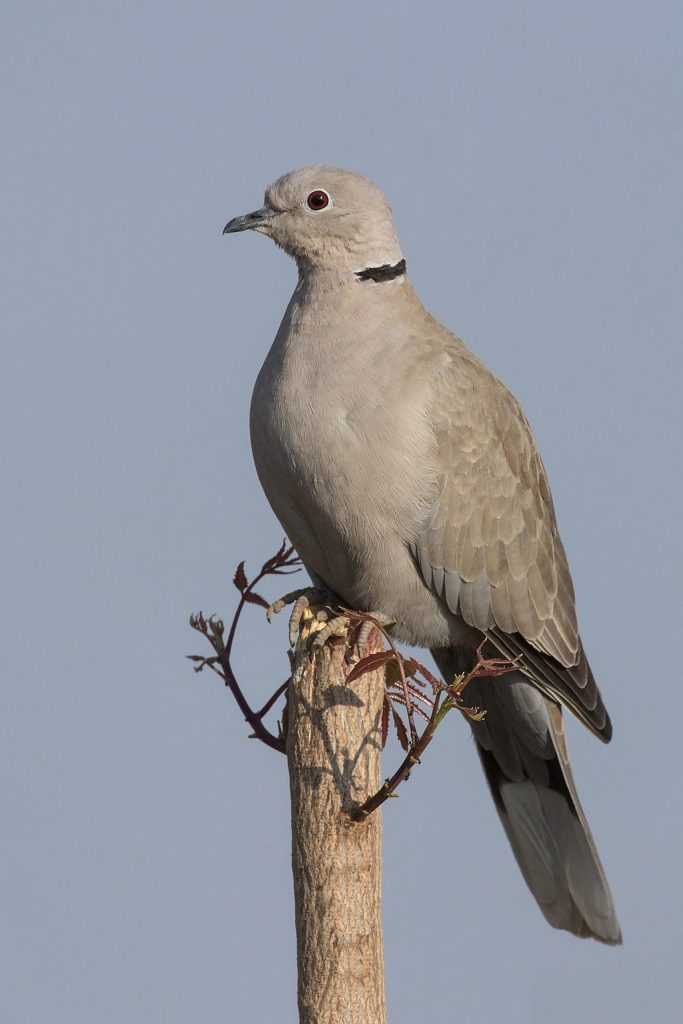
Coloration and Markings: These inquisitive little characters have simple, but lovely coloration and markings. Eurasian Collared Doves are gray or light brown on their back, wings, and their long tails. These tails have white patches and when seen in flight you will notice a large amount of white on the undersides of the wings and tail. They have gray or light brown breast and underbelly and long necks, leading to a gray or brown face with color concentrated a little more towards the back of the head and being lighter in the front. A distinctive half-collar mark is present on this bird’s neck, going from mid-neck and around the back of the head to the other side, and this bird has a medium-length, slightly curved black bill.
Size: These birds measure in at 11.4 – 11.8 inches in length with a wingspan of approximately 13.8 inches.
Habitat: These birds might visit the woods when it gets chilly, but aside from this exception they are almost always found near human habitations. Whether raiding spilled grain at farms or strolling the city sidewalks, the Eurasian Collared Dove is very much a ‘civilized’ bird. They will happily visit a well stocked feeder.
Diet: These birds are easy to please, just put out a simple mix of Black Oil Sunflower seeds and White Proso millet and you’ve got a recipe for a happy Dove.
Lewis’s Woodpecker – Melanerpes lewis

Coloration and Markings: Lewis’s Woodpecker is a real looker. These birds are black-green on their backs, wings, and their long tails. Their breast is half gray and half pink rosy-hued and this rosy color continues down to the underbelly while the gray from the breast continues all the way up the neck to chin level. Facially, this bird has a black face with a large, wide rosy mask which stops at the back of the eyes on the horizontal and vertically it ranges from above the eyes down to the cheek. These birds have long, straight black bills.
Size: These birds measure in at 10.2 – 11 inches in length with wingspans of 19.3 to 20.5 inches.
Habitat: These birds love open Pine forests, Oak stands, and meadows (especially next to streams). They will also visit orchards, gardens, and the occasional backyard.
Diet: These birds eat insects, nuts, and berries, so try leaving out some peanuts and fresh or dried Blueberries and you might just get this Woodpecker’s attentions.
American Robin – Turdus Migratorius
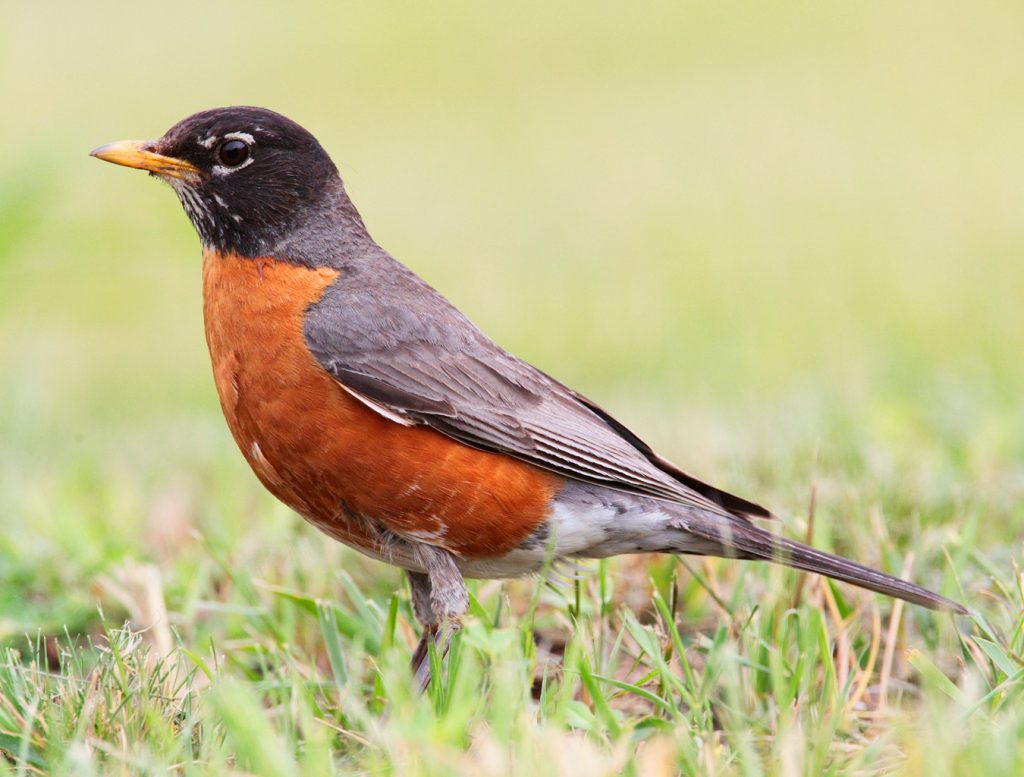
Coloration and Markings: American Robins have brownish-gray backs, long grayish wings, and long grayish-black tails with white undersides. They have an apricot-orange breast and underbelly, with a white rump and facially, the male Robins are black. A distinct fragmented white eyering is present and these birds have medium-length, slightly curved yellow bills. Females will appear much the same but their heads will be a lighter color.
Size: These birds measure in at 7.9 – 11 inches in length with wingspans of 12.2 to 15.8 inches.
Habitat: These birds love deciduous and Pine forests but they also enjoy the cover of shrubs and other dense vegetation when out in the wild. They are also somewhat urbanized, so don’t be surprised if you see an American Robin at the golf course or perched on a telephone wire. These birds aren’t shy about inhabited areas and will happily visit backyard feeders.
Diet: These birds ignore birdseed but you might just get their attention with some dried mealworms and chopped apples. Give it a try and see what happens!
Black-capped Chickadee – Poecile atricapillus
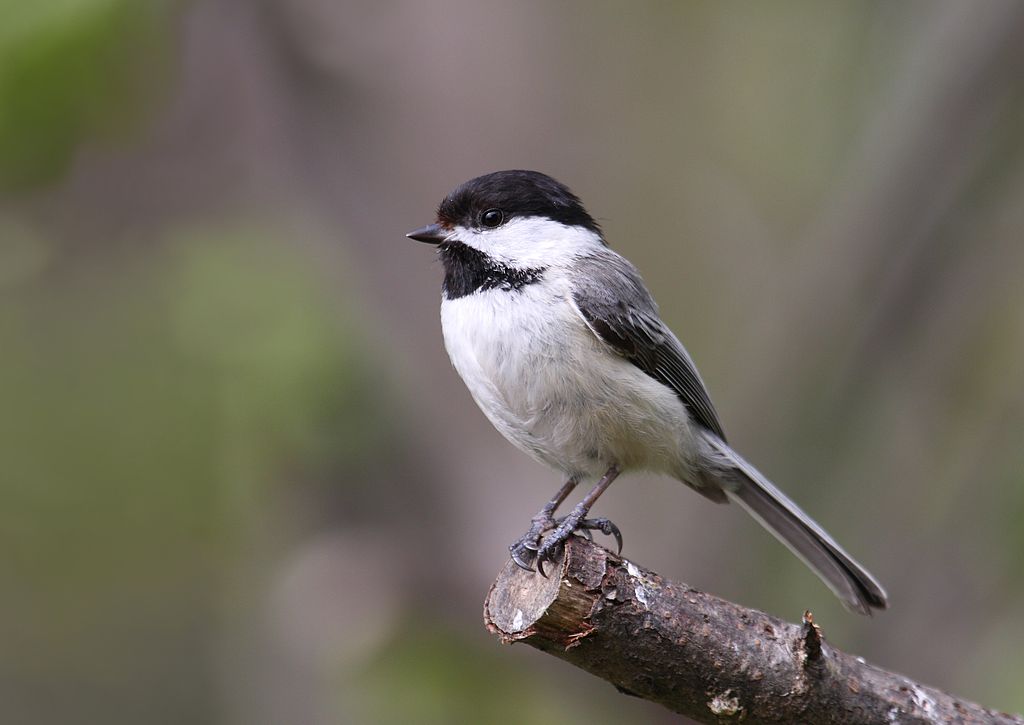
Coloration and Markings: Black-capped Chickadees have smooth gray backs, with short gray wings sporting minute white highlights, and long, gray tails with white edging. They have snowy-white breast and underbelly and white faces, with the exception of a black bib and a large black cap that terminates vertically just under the eyes. These birds have tiny, conical black bills.
Size: These birds measure in at 4.7 – 5.9 inches in length with wingspans of 6.3 to 8.3 inches.
Habitat: These birds may be found anywhere there are trees and dense vegetation. Marshes, overgrown fields, brambles, and thickets. If you have some shrub cover in your backyard then this will increase your odds of a visit but if not, just stock up that feeder and if the Black-capped Chickadee notices then you might just get a visit anyway!
Diet: Suet, chunky peanut butter, and Black Oil Sunflower seeds are all favorites of the Black-capped Chickadee. Put out one or more and you might just get a visit!
Colorado’s Birds of Spring, Summer, and Early Fall
The fun starts in spring, when the Denver post cheerfully advises us you can see some definite signs of the season’s arrival, such as dandelions sprouting, rainbow trout in the rivers, and yellow parking tickets for those who have left their cars out before the major sweeping can begin. This is when the spring stars of the skies will arrive and get quite active. See if you can spot some of these little Avian wonders:
- Lark Bunting
- Broad-tailed Hummingbird
- Western Meadowlark
- Barn Swallow
- Lesser Goldfinch
Lark Bunting – Calamospiza melanocorys

Coloration and Markings: During mating season the male Lark Bunting, State Bird of Colorado, had a black back with long, black wings with large white patches towards the tips and some minor white coloration on the rest. They have long, black, white-tipped tails and a black breast and underbelly. These birds have long, black necks and faces and a large, conical silvery bill. Out of mating season, the male looks the same as juvenile and female Lark Buntings, with brown coloration on their upper bodies and brown streaking on their breast and underbelly. The white patches on the wings will be more distinct at this time and are a dead-giveaway when identifying this bird.
Size: These birds measure in at 5.5 – 7.1 inches with wingspans of 9.8 to 11 inches.
Habitat: These birds are seen most often in open fields and grasslands, especially where there is a good amount of brush and shrub cover to let the Bunting feel secure while foraging.
Diet: Insects make up the majority of this bird’s diet but they supplement with grains, seeds, and fruits, so if you want to hedge your bets you might try leaving out some dried mealworms or crickets with chopped apples, White Proso millet, and Black Oil Sunflower seeds.
Broad-tailed Hummingbird – Selasphorus platycercus

Coloration and Markings: Broad-tailed Hummingbirds are a shimmery emerald color on their backs and wings with the wings sometimes having a little gray towards the tips, but not always. They have small, gray tails which show white underneath when the bird is in flight. This bird has a white breast and underbelly, flanked with green as if it is wearing an emerald vest. You will also note a deep ruby coloration from the throat to just under the bill and this coloration is wide, spreading from shoulder to shoulder. The top and back portions of the head are green and they have long, thin black bills. Females and immature Hummingbirds will have green throats and cheeks and you might notice a pale white eyering.
Size: These little angels measure 3.1 – 3.5 inches from tip to tail and have wingspans of approximately 5.25 inches.
Habitat: These birds prefer higher elevations and may be seen in the woods, meadows, and occasionally at the forest’s edge. They do range occasionally when foraging and if you are lucky they might just notice your feeder.
Diet: Broad-tailed Hummingbirds eat insects and nectar. A standard Hummingbird feeder with sugar water will make them happy and you might also try leaving out some dried mealworms for them to see if they are tempted.
Western Meadowlark – Sturnella neglecta

Coloration and Markings: Western Meadowlarks will definitely make you do a double-take. Their back, wings, and medium-length tails have an elaborate scaling pattern made of brown encircled with thin lines of white. The tails have some noticeable white edging and the breast and underbelly are a contrasting yellow in color, with a flanking of white with dark spots which continues down to the rump. On the breast, this bird have a distinct black marking that looks as if the bird is wearing a necklace. Above the v-shape of the necklace this bird is yellow, travelling from the base of the throat to underneath the bill but this yellow just goes straight up. It does not enter the rest of the face, which is white with gray peppering underneath the eyes and across the cheek, a brown eyeline that goes from the bill to the back of the head, and a brown stripe at the top of the head. This bird has a long, straight gray bill.
Size: Roughly Robin-sized, these birds measure in at 6.3 – 10.2 inches in length with wingspans of approximately 16.1 inches.
Habitat: These bird love open areas, such as wide open fields, grasslands, or even the marshes edge. As long as there is a little cover then these birds are comfortable.
Diet: While they make up most of their diet with insects, seeds and berries are often gobbled up by the Western Meadowlark for a little variety. Try leaving out some Blueberries or chopped cherries and Black Oil Sunflower seeds. You might just tempt one to visit.
Barn Swallow – Hirundo rustica
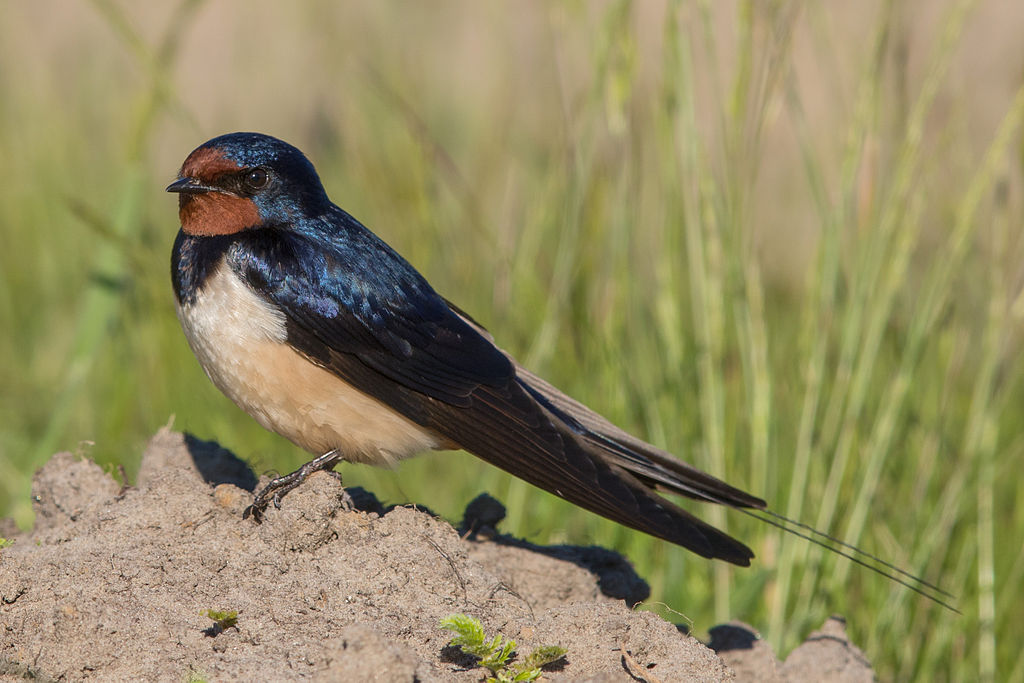
Coloration and Markings: Barn Swallows look like superbirds! They have a deep blue to purple-blue plumage on their backs, wings, and their long, forked tails with dim, white spots. The blue extends from the back onto the breast, with a thick line showing from each sbhoulder and moving diagonally towards the center of the breast as if the bird is wearing a cape. Often above the ‘cape strings’ these will be white lines above the shoulders as well. The breast and underbelly of this bird are a rich cinnamon-orange color and this orange collar extends into the face, outlining the underside of the cheeks and triangulates to its termination just above the bill. Above this, the birds face is a deep blue which seeps down into the lower face and stops at the bottom of the cheeks. This bird also have diamond-shaped black mask markings to complete the superhero look and a tony, straight black bill.
Size: These birds measure in at 5.9 – 7.5 inches in length with wingspans of 11.4 to 12.6 inches.
Habitat: Barn Swallows love open areas such as fields, parks, meadows, and even roads. They are also fond of water, so look for them as well at the edge of streams, ponds, or marshes and you might just spot one!
Diet: Barn Swallows usually ignore the standard feeder-fare, but you can leave out some crushed eggshells and that might get their attention. They eat them, in theory, to aid in digestion. While we can’t confirm that’s the true reason, leaving out the crushed eggshells works so give it a try and see for yourself!
Lesser Goldfinch – Spinus psaltria
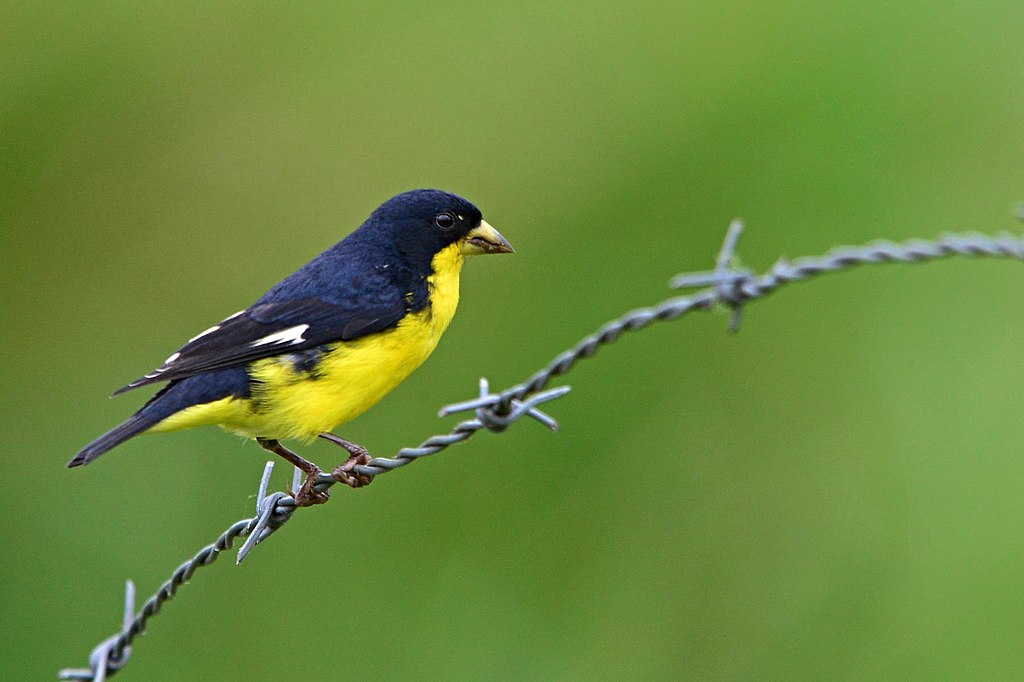
Coloration and Markings: The Lesser Goldfinch looks almost like a colorful Avian executioner. They have black (sometimes greenish) backs, long green or black wings, and short tails of the same color though with white corners. The wings will have a few white patches and their breast and underbelly id a bright yellow that continues up to the throat and just under the bill, showing widest where it stops halfway across the neck, then in front of the cheek. The remainder of the head is black and the effect produced looks exactly like the bird is wearing a black hood. These birds have medium-length, slightly curved yellow bills. Females and juveniles will have olive coloration on their backs, black wings, and muted yellow below. The wings will display distinct bright wingbars.
Size: These birds measure in at a mere 3.5 – 4.3 inches in length and have wingspans of 5.9 to 7.9 inches.
Habitat: These birds like open areas with a little cover, whether it be in in the high treetops admist heavy saturations of leaves or in some shrubs or brambles below. When foraging they’ll even venture into canyons and they are not uncommon in residential areas, so keep an eye out and a your feeder loaded and ready.
Diet: An easy mix to tempt the Lesser Goldfinch is hulled Black Oil Sunflower seeds and Nyjer thistle. These little guys can’t get enough!
Colorado’s Fall and Winter Birds
With lows around -7 degrees Fahrenheit, Colorado winters are not for the faint of heart. The birds we’ve collected for this section of our article are nonplussed about all of this snow and ice and may still be seen, hopping in the snow or perched on frosty limbs as they prepare to do some serious forging in the serious Colorado winter. See if you can spot one of these hardy fellows:
- Northern Flicker
- American Bushtit
- Townsend’s Solitaire
- Brown-Capped Rosy-Finch
- Purple Finch
Northern Flicker – Colaptes auratus
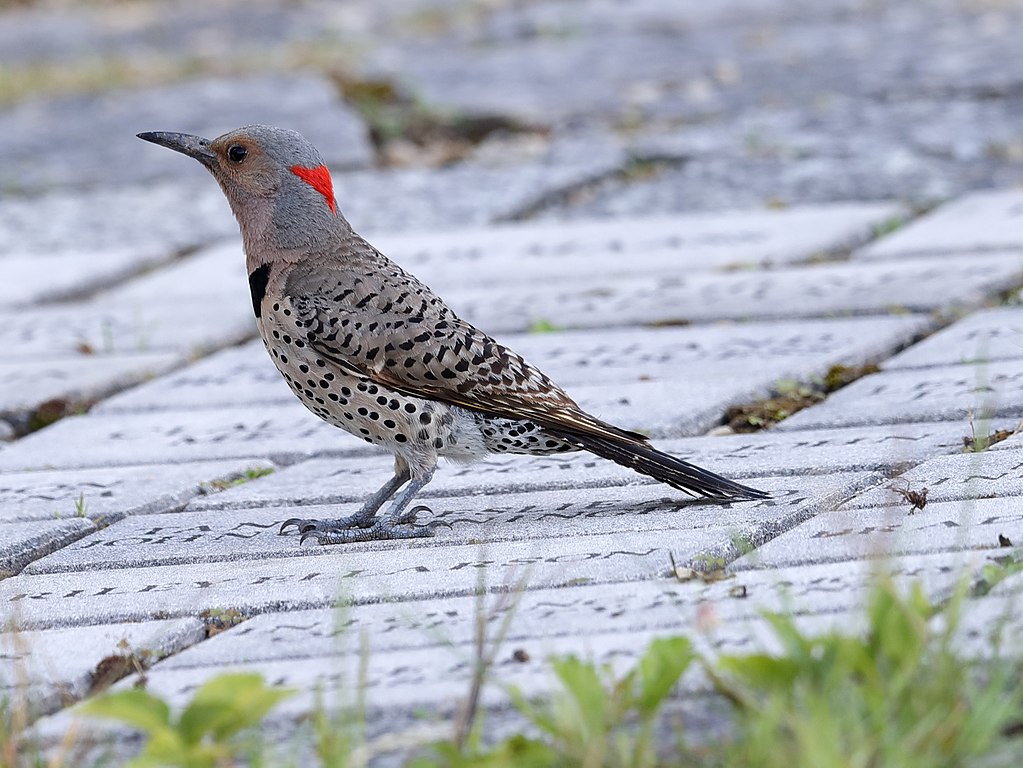
Coloration and Markings: Northern Flickers typically have gray or brownish back and wings with black spots and lines marking the length of the long wings. They also have long, black fanning tails which are bright yellow or red and black-tipped on the undersides. The rump of this bird is white, but this is very hard to see unless the bird is in flight. The breast and underbelly of the Flicker is brown or gray with numerous spots and a distinctive black crescent mark is present at the apex of the breast. Facially, these birds are smooth brown or gray with a red stripe crossing from bill to cheek and a black line underneath this. A brown eyeline is often present and this bird has a long, curved gray bill.
Size: These are good sized birds, measuring in at 11 – 12.2 inches in length with wingspans of 16.5 to 20 inches.
Habitat: These birds love the forest’s edge, as well as parks and spacious backyards. In general they prefer the outskirts of the woods rather than to be deep inside of them.
Diet: While these birds generally don’t visit feeders, you can occasionally tempt them with suet cakes. A non-feeding option that works well is to put out a birdbath, as Northern Flickers will generally take advantage of one if they notice that it is there.
American Bushtit – Psaltriparus minimus

Coloration and Markings: American Bushtits have simple coloration, being brown and gray on their back, wings, and on the long, black-tipped tails. The wings have minute accents of white and black and their tails are white on the undersides. The breast and underbelly of this bird are typically white with a mix of light gray and this coloration extend upward, becoming pure white just at the throat and extending across over the top of the wings and stopping at the back of the head. Around the eyes and cheek the face is more of a standard gray while the upper portion of the head and the back are a grayish-blue. These birds have tiny, lightly curved black bills.
Size: These tiny birds measure in at only 2.8 – 3.1 inches from head to tail and they have wingspans of approximately 6 inches.
Habitat: These little birds like dense vegetation and move through it with ease, most often travelling in flocks. They have been known to visit feeders so you may want to overstock in case they’ve brought a few friends.
Diet: These little guys love suet and the rumor has it that they’ve been seen at feeders eating olives with happy abandon. Give it a try for yourself and see!
Townsend’s Solitaire – Myadestes townsendi

Coloration and Markings: Townsend’s Solitaire actually has the most interesting coloration as a juvenile. As an adult, look for a bird which is completely smooth gray with the exception of white outer tail feathers and the occasional buff patches on the wings. Beyond this, you should see a thin white eyering on this bird and it has a short, straight black bill. Juveniles are a darker gray but the breast, underbelly, and face have a heavily ‘scaled’ appearance made from a combination of brown and black spots like a brown and black Harlequin.
Size: These birds measure in at 7.9 – 8.7 inches in length with wingspans of 13 to 14.6 inches.
Habitat: These birds love open Pine and Fir forests and just about anywhere that you can find Juniper berries (see below).
Diet: These birds are unlikely to visit your feeder but if you have Juniper bushes then you are in luck, as these berries are what the Townsend’s Solitaire primarily eats.
Brown-Capped Rosy-Finch – Leucosticte australis

Coloration and Markings: The Brown-capped Rosy-Finch has some lovely coloration. The back is brown or brownish gray and the bird has grayish wings, with some rosy pink present from the shoulder area going down each wing. The long tails of this bird are a lighter gray with some symmetrical pairings of pink marks going down its length. The breast of this bird, by contrast, is a rich brown which becomes rosy-hued as it approaches the underbelly. The brown coloration from the breast next goes up the throat and to the face, filling it and terminating at a level just above the eye. The upper portion which remains on the face is grayish-brown and this bird has a short, stout, and slightly curved black bill.
Size: These birds measure in at 5.5 – 6.3 inches from head to tail with wingspans of approximately 13 inches across.
Habitat: These are mountain birds but they do tend to range, especially in winter when they are frequent visitors to backyard feeders. Leave a little something out for them to ward off the chill and you might just earn some repeat visits!
Diet: Black Oil Sunflower seeds and Nyjer thistle are a good mix to set out for these birds. Though they primarily eat insects they also love seeds so be sure to give this mix a try.
Purple Finch – Haemorhous purpureus
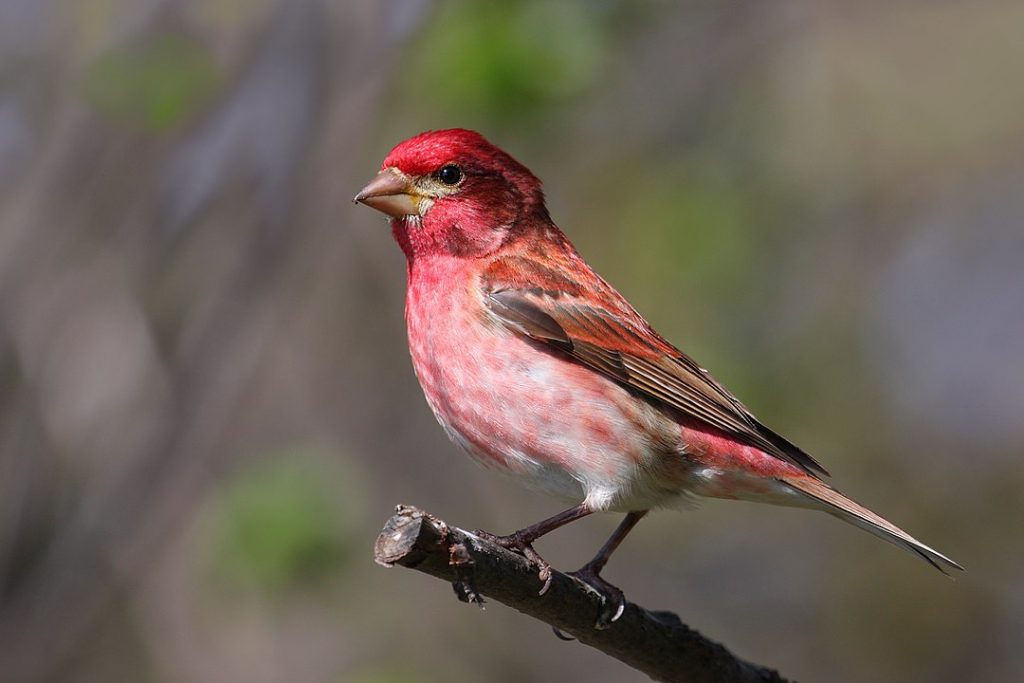
Coloration and Markings: Male Purple Finches are a sight to see. They to have pink and red hues painted on their brown backs, wings, and their short, notched, white-edged tails. The breast of this bird is white with heavy rosy spotting which turns into fainter rosy streaks on the underbelly until reaching the rump, where the plumage becomes completely white. Facially, the bird has a raspberry colored face with a thick, dark eyeline which curves down to the cheek and often continues under to frame it and a darker stripe at the top of the head. This bird has a powerful, yellow, conical bill. Females will not have any rosy coloration, but instead brown or olive on top with heavy streaking below. A white eyestripe is visible and a black line is often seen on the throat.
Size: These birds measure in at 4.7 – 6.3 inches in length with wingspans of 8.7 to 10.2 inches.
Habitat: These birds love coniferous and deciduous woods during the warm months but when winter arrive then you can find them in fields, parks, and backyards.
Diet: These birds love Black Oil Sunflower seeds and are quite fond of fruit as well. Add some chopped up apples or oranges and if they notice then they will likely come in for a closer look.
Supporting cast (Other Backyard Birds or Colorado that might pay you a visit)
We thought that we might add some extra birds which can see at anytime of the year. While they don’t get the fancy front-page intro, all of these birds are celebrities all by themselves and are well worth stocking up that feeder for. See if you can spot one or more of the ‘Supporting Cast’ birds listed below:
- Cedar Waxwing
- Dark-eyed Junco
- European Starling
- Mourning Dove
- House Finch
Cedar Waxwing – Bombycilla cedrorum
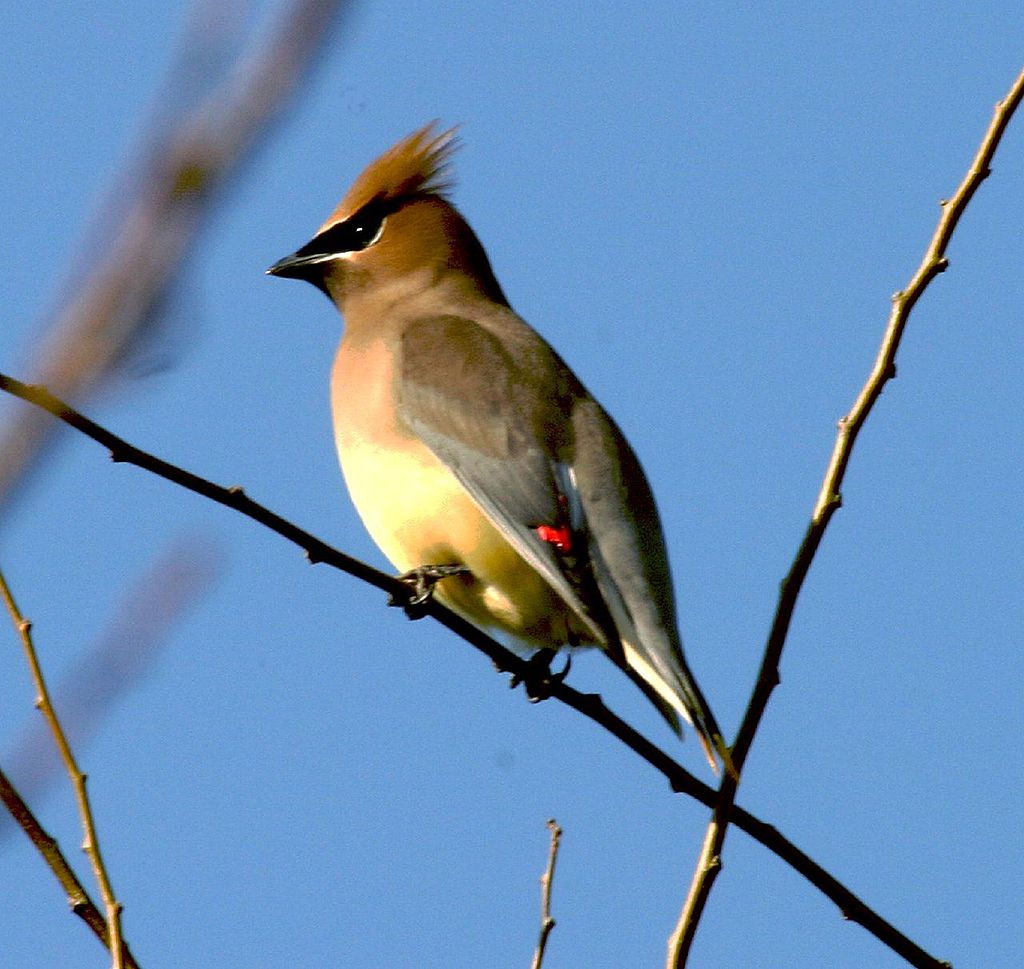
Coloration and Markings: Cedar Waxwings are quite good looking. With the shoulders and back starting out as brown becoming a smooth gray on the lower back, wings and the short tail which is tipped with yellow under a line of black. The wing shows some waxy-red moving across it a little over halfway down the wing and at the top of this a white line begins which moves up and terminates at the brown of the shoulder. Underneath the red-wax marks some black travels down to the wingtips. The breast of this bird is a mix on light brown and yellow, with the yellow deepening as the color approaches the underbelly and facially, this bird is a smooth, light brown. A long, bearlike brown bib is present that terminates a little into the breast and this bird also has a fine, brown crest. Immediately underneath the crest is a black mask which passes through the eyes and curves upwards towards the back of said crest. The mask has thin, white accenting lines above and below the mask and this bird has a short, slightly curved black bill.
Size: These birds measure in at 5.5 – 6.7 inches in length with wingspans of 8.7 to 11.8 inches.
Habitat: These birds love any type of forest and venture out often to visit farms, orchards, and backyards. If you have some fruiting plants in your backyard then this will greatly increase your chances of a visit.
Diet: At zoos these birds are fed seeds, fruit, and mealworms, so just about any fruit and seed combo is likely to be greeted with enthusiasm. You can throw in some dried mealworms if you like but if you are putting out fresh fruit such as chopped apples then likely this is all that you need.
Dark-eyed Junco – Junco hyemalis

Coloration and Markings: Dark-eyed Juncos have simple but elegant coloration. Their back, short wings, and long tails are brown or dark gray, with the underside of the tail being a frosty white. The breast of this bird is whitish in the center, heavily flanked with dark gray which lessens a bit as it approaches the underbelly and becomes completely whitish at the rump. The face of this bird is dark gray or brown and it has a short, stout pinkish conical bill.
Size: These birds are 5.5 – 6.3 inches long with wingspans of 7.1 to 9.8 inches.
Habitat: These birds love coniferous woods but may be found in any wooded environment that is fairly open. This includes places such as meadows and park but they also love other open areas such as fields and big backyards.
Diet: You can make Juncos happy with some cracked corn, White Proso millet, and hulled Black Oil Sunflower seeds.
European Starling – Sturnus vulgaris
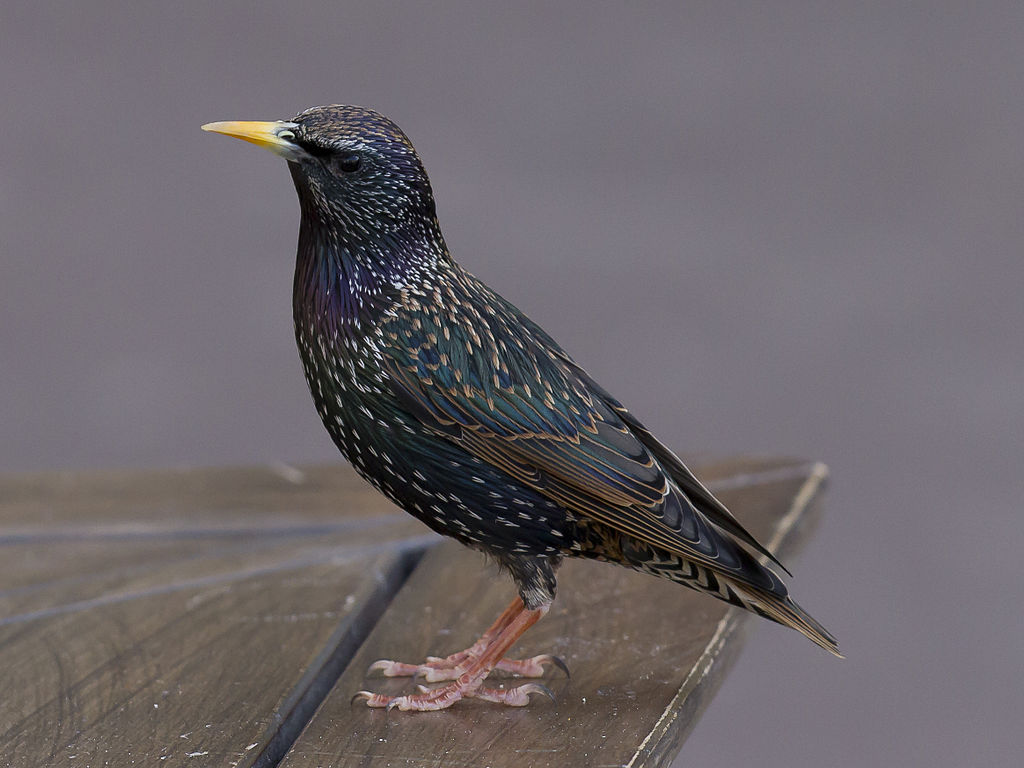
Coloration and Markings: European Starlings are pretty and easy to identify. Their entire bodies are a shiny purple-green that looks like black from a distance and facially they have long, straight yellow bills. In the winter they molt into a very different guise, becoming brown with bright, white spots!
Size: These birds measure in at 7.9 – 9.1 inches from tip to tail and have wingspans of 12.2 to 15.8 inches.
Habitat: These are town and country birds, who frequent fences and phone wires and walk proudly down the sidewalk. They are confident and more than happy to visit a backyard feeder.
Diet: White Proso millet and Black Oil Sunflower seeds will attract a European Starling but you can also get a lot of mileage with peaches, plums, or pears. Cut them up fresh and serve via your feeder and you might see some excellent results.
Mourning Dove – Zenaida macroura
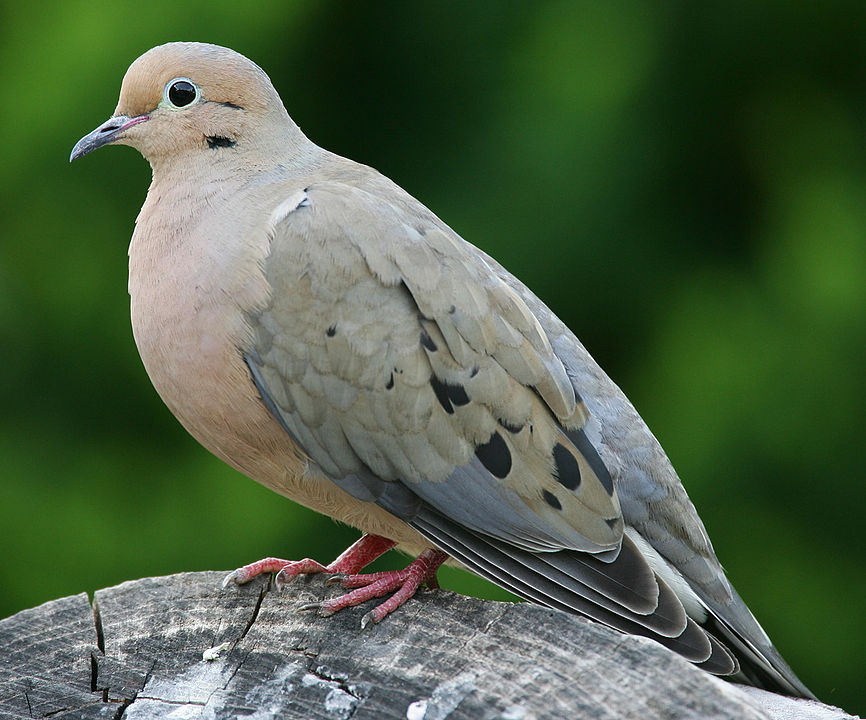
Coloration and Markings: The Mourning dove has a tan and gray back, with long, gray wings heavily saturated in the centers with creamy tan coloration and distinctive black spots. They have long, gray and rather pointy tails, which is unique compared to the other American Doves, and these tails have black borders on them which you will notice as well. The breast of this bird is white mixed with rich tan and this coloration lightens as it approaches the underbelly. The tan color is at its richest in the face, where you will see a distinct white eyering and this bird has a straight, medium-length black bill.
Size: These Doves measure in at 9.1 – 13.4 inches in length with wingspans of approximately 17.7 inches.
Habitat: These birds prefer fields and clearings to deep woods and often visit parks and backyard feeders without the slightest hint of shyness.
Diet: Cracked corn, peanuts, and Black Oil Sunflower seeds are a winning combination that can often lure the Mourning Dove and keep them coming back for more.
House Finch – Haemorhous mexicanus
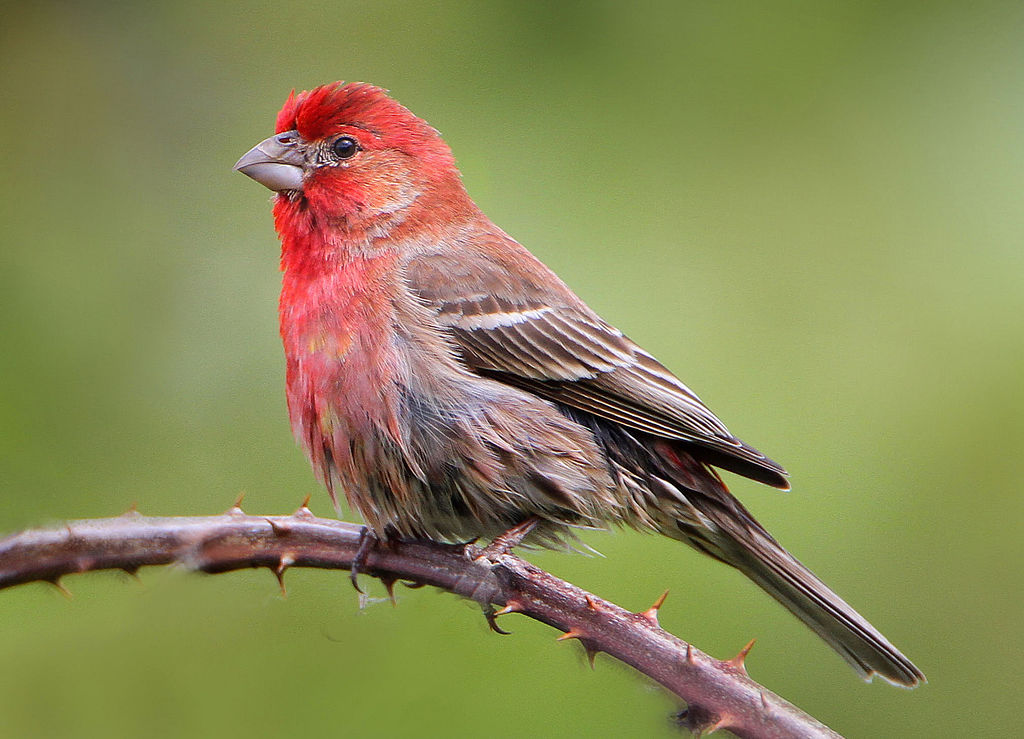
Coloration and Markings: House Finches have lovely markings, with gray backs, wings, and long, gray tails with white on the outsides. Their breast is white with a heavy concentration of rosy-red hues which turns into fainter red or dark streaking as it approaches the underbelly. Facially, this bird has a rosy face, with deep concentrations at the cheek and the upper portions of the head. A gray eyeline is present which passes through the eye, splitting, with one mark framing the cheek while another branches towards the lower back of the neck. Females lack these distinctive markings and are brown or brownish gray with heavy streaks. These birds have short, stout, and slightly curved gray bills.
Size: These birds measure in at 5.5 – 5.5 inches in length with wingspans of 7.9 to 9.8 inches.
Habitat: In Nature these Finches love the forest’s edge, open fields, or even desert plains. They love the city, though, and are often seen in parks, golf courses, and backyards as well.
Diet: House Finches will eat a lot of things but the easiest and most practical lure is going to be Black Oil Sunflower seeds. These guys tend to visit in flocks so stock up on the seeds and you might have a very entertaining morning or afternoon.
Colorado Bird Buffet
If you are looking to compile a combination of the most effective feeds to use together to attract the most diverse crowd of fine feathered friends then we have a little advice today from ourselves and from the folks at Echter’s Garden and Nursery center. There are some excellent foods to load up your feeder with that can get some concrete results. From what we have read and researched you should consider the following:
- Black Oil Sunflower
- Peanuts
- White Proso millet
- Nyjer thistle
- Raisins
- Blackberry preserves
Colorado Birding Hot Spots
The Chirparazzi know where to get the best photos and would like to share with you some of Colorado’s hotspots for finding and maybe even getting photos of some of those elusive winged celebrities we love so much. If one of these sites is not close to your region, please check our reference link below and you can surely find a nice park or trail where you can spend some time with your fine, feathered friends. Check out one or more of the following hotspots if you want to see some happy birds going about their day in their beautiful, natural habitats:
- Northern hotspot – Fraser River Trail
- Eastern hotspot – Fountain Creek Regional Trail
- Southern hotspot – Monarch Spur Trail
- Western hotspot – Colorado River Trail
- Central hotspot – Alpine Tunnel Trail
Detailed descriptions of each location as well as information regarding visiting and what birds you can see at these locations may be found at https://www.traillink.com/stateactivity/co-birding-trails/
In Closing
Today we have discussed the popular backyard birds of Colorado and we hope that you have had as much fun reading this as we have had writing it. With its 500+ birds and the striking scenery, Colorado is a place where one can happily spend the rest of their lives enjoying the view and the glorious creatures of Nature. We wish you the best of luck on your next birding run and as always, be patient, don’t forget your binoculars, and pack something yummy for yourself and any winged strangers you might happen to meet. You’ll be happy that you did!
